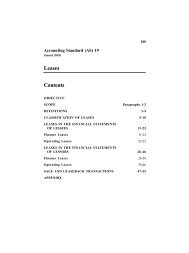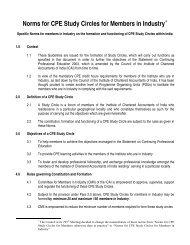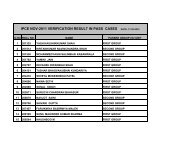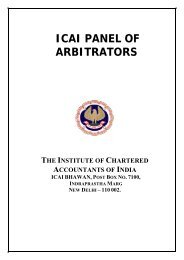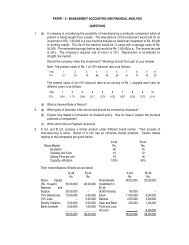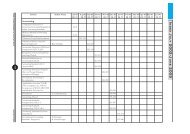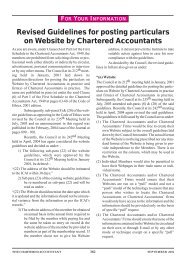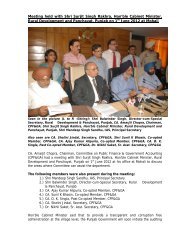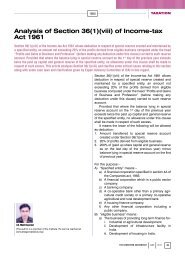The Chartered Accountant
The Chartered Accountant
The Chartered Accountant
Create successful ePaper yourself
Turn your PDF publications into a flip-book with our unique Google optimized e-Paper software.
A. Facts of the Case<br />
1. A private limited company manufactures<br />
nickel sheets using the electroforming<br />
process. <strong>The</strong> key plant<br />
and machinery for the manufacturing<br />
process is an electroplating tank<br />
consisting of:<br />
(i) Pure nickel in pellet form,<br />
and<br />
(ii) Nickel Sulphamate Solution.<br />
2. <strong>The</strong> principle of operation is that<br />
of electroplating. In electroplating,<br />
there are two electrodes dipped in<br />
an electrolyte solution (Nickel Sulphamate<br />
solution). <strong>The</strong>y are given<br />
opposite electric charges; the electrode<br />
having positive charge is called<br />
Anode and the one having negative<br />
charge is called Cathode. When the<br />
electric charge is applied, Anode<br />
dissolves in the electrolyte and the<br />
metal that has dissolved gets deposited<br />
on the Cathode. <strong>The</strong> Anode<br />
consists of a perforated titanium<br />
basket filled with the nickel pellets.<br />
<strong>The</strong> nickel in the basket dissolves in<br />
the nickel sulphamate solution. <strong>The</strong><br />
Cathode consists of a metal sheet.<br />
<strong>The</strong> nickel that dissolves from the<br />
Anode gets deposited on the Cathode,<br />
thus the product is ready. In the<br />
normal course of operation, whatever<br />
nickel is taken away from the<br />
Anode is replenished by way of addition<br />
of fresh nickel pellets.<br />
3. To get the production started and<br />
then to maintain the desired quality<br />
of product, it is absolutely essential<br />
that the quantity of nickel in the<br />
Anodes as well as the quantity and<br />
concentration of nickel sulphamate<br />
DECEMBER 2008 976 THE CHARTERED ACCOUNTANT<br />
OPINION<br />
Treatment of initial quantity of<br />
in-process material.<br />
<strong>The</strong> following is the opinion given by the Expert Advisory Committee of the Institute in response<br />
to a query sent by a member. This is being published for the information of readers.<br />
solution be maintained as per the<br />
standards. Unless nickel and nickel<br />
sulphamate solution is added to the<br />
tank the same cannot be put to use.<br />
4. In short, according to the querist,<br />
the quantity of initial nickel and<br />
nickel sulphamate solution that is<br />
put inside a tank stays for the entire<br />
operational life of the tank. Hence,<br />
the cost of initial nickel and nickel<br />
sulphamate solution is treated as<br />
capital cost for the purpose of obtaining<br />
term loan for buying six new<br />
tanks in the financial year 2007-08.<br />
Besides the six new tanks added in<br />
the financial year 2007-08, the company<br />
has twelve old tanks where<br />
the cost of initial nickel and nickel<br />
sulphamate solution has not been<br />
considered as capital cost and the<br />
balance stock in the tanks as on the<br />
balance sheet date is shown as workin-progress.<br />
As per the querist, this<br />
being major addition, management<br />
of the company felt it necessary to<br />
ascertain as to whether capitalisation<br />
of cost of initial nickel and nickel<br />
sulphamate solution is proper.<br />
B. Query<br />
5. <strong>The</strong> querist has sought the opinion<br />
of the Expert Advisory Committee<br />
on the following issues:<br />
(i) Whether the accounting treatment<br />
given by the company<br />
to treat the cost of nickel and<br />
nickel sulphamate solution in<br />
the six new tanks, acquired in<br />
the financial year 2007-08, as<br />
capital expenditure is correct.<br />
(ii) In case the answer to the<br />
above question is in the af-<br />
firmative, then whether it is<br />
necessary to declare the same<br />
as a change in the accounting<br />
policy for fixed assets, since<br />
nickel and nickel sulphamate<br />
solution in earlier tanks has<br />
not been capitalised.<br />
(iii) In case the answer to (i) above<br />
is in the affirmative whether<br />
it is possible to transfer the<br />
work-in-progress (WIP) to<br />
capital asset in respect of earlier<br />
12 tanks in the financial<br />
year 2007-08. This, according<br />
to the querist, will be done by<br />
transferring WIP to fixed assets.<br />
If it is possible, the following<br />
questions arise:<br />
(a) At which price transfer<br />
from WIP to Fixed assets<br />
should be made, whether<br />
at today’s price (carrying<br />
cost) or the price at which<br />
it was originally purchased,<br />
i.e., 1998 price.<br />
(b) Whether depreciation<br />
from the date of capitalisation<br />
(1998) to date<br />
should be considered.<br />
(c) If WIP is transferred at<br />
1998 price, what treatment<br />
should be given<br />
for the balancing amount<br />
(difference between the<br />
present WIP value and<br />
1998 price).<br />
(iv) Whether the company can<br />
adopt dual accounting policy,<br />
i.e., continue to show the<br />
nickel and nickel sulphamate<br />
solution in the earlier 12



